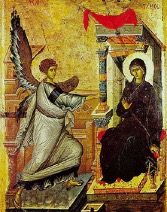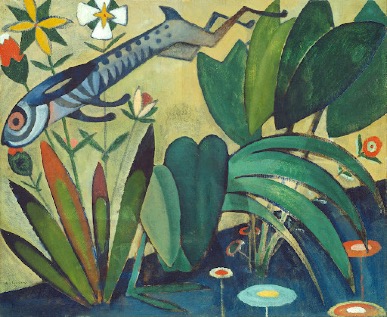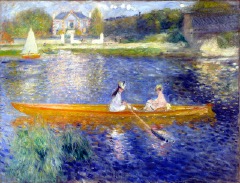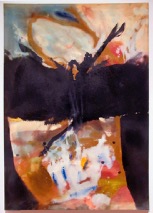Nigel Halliday - Rookmaaker and art theory
Rookmaaker and Art Theory
Nigel Halliday

Andy Goldsworthy, Storm King Wall by barryleiba under CC BY-NC-ND 2.0
Fifty years after publication the opening chapters of Modern Art and the Death of a Culture still offer one of the best simple introductions to a Christian view of the history of art. It emphasises the role of visual analysis, showing how the facture of the work is essential to convey its meaning. It is also notable because Rookmaaker’s account of Western art rests on history rather than theory.
The individualism and fragmentation that flowed from the Enlightenment brought an avalanche of theory upon the fine arts, as philosophers sought to explain the nature and role of art, and artists and critics laboured to justify their choices of style and content. This weight of words was engagingly mocked by Tom Wolfe in The Painted Word, and can be felt in the twin tomes of Art in Theory which take nearly 2,500 pages to span the 19th and 20th centuries.[1]
The subtitle of the latter work, An Anthology of Changing Ideas, suggests the inconclusiveness of these efforts. So too does Nigel Warburton’s The Art Question, which outlines five main modern theories of art, beginning with the views that art is about either aesthetic appreciation of form or the expression of emotion, before descending along a road of despair: that it’s art because it has family resemblances to some other objects already recognized as “art”; because someone says it’s art and puts it in a gallery; or, finally, that no definition is possible. Warburton argues sympathetically for the pluses and minuses of each theory, but in the end shows them all to be wanting.[2]

Ohrid Annunciation Icon
Rookmaaker, by contrast, simply explains the history of art as having evolved from medieval icon making. An icon points the viewer to a spiritual reality: something to be believed and worshipped. This, he then shows, is what unites the subsequent Western canon: paintings and sculptures point beyond themselves to deeper realities, to the ultimate commitments of either the artist or their society; to beliefs about spiritual truth or the values by which we should live; or, as the culture becomes increasingly secular, to the fundamental question of what is real.[3]
The absence of overt theory in Rookmaaker’s account seems to have been a result not of neglect, nor of the fact that he was writing for a non-academic audience, but of conviction. In an early essay “Science, Aesthetics and Art” published in 1949, and explicitly rooted in Dooyeweerdian philosophy, he rejects the modern priority given to theorisation and espouses what he calls “naïve” experience.[4] Where the Enlightenment, with its Cartesian conviction that the human mind is the arbiter of truth, was smitten with difficulty in finding a convincing proof that anything else existed, for Rookmaaker, rooted in Christian faith and a philosophy arising from it, reality is a given, and we encounter it with a non-theoretical directness. As with reality in general, so with art in particular: it is a given to be explored rather than justified theoretically. In a similar way, Graham Birtwistle has also observed that both Rookmaaker and Francis Schaeffer avoided giving a definition or theory of “art” but based their discussions of art in creativity, another given rooted in our being made in the image of our Creator God.[5]
Despite the absence of overt theory, it is possible to reconstruct from his writings what Rookmaaker regarded as normative for a work of art: that art was essentially a communication relating to matters of religious or philosophical significance; it must therefore be rooted in representation, or else there is no medium for communication. Mere representational accuracy, however, was inadequate: the artist needed to make aesthetic adjustments in their depiction in order to convey their meaning.

Amadeo de Souza Cardoso, The Leap of the Rabbit
It is worth also noting that Rookmaaker used to describe himself as being close to or part of the Panofsky school of art history.[6] Erwin Panofsky, reacting against the formalism of 19th-century art history, founded the discipline of “iconology” which saw art as “embodied ideas” which could be decoded.[7] Rookmaaker shares with Panofsky a commitment to understand a work of art in its social context, arguing that artists would, whether deliberately or unwittingly, express aspects of their wider contemporary culture in their work. However, whereas Panofsky would sometimes jokingly admit that someone might try to practise iconology by looking at small photographs in a book, Rookmaaker’s insistence on the role of materials and facture meant that first-hand engagement with the object was always necessary.
Although one may in this way attempt to outline a norm of art in Rookmaaker’s understanding, it is still rooted in the explanation of art history as received, not theoretical presuppositions. And this approach, I believe, is helpful not only in offering Christian answers to some post-Enlightenment problems, but in answering some key questions about the arts.
Firstly, Rookmaaker helps to disentangle what we loosely call “art” but might be more helpfully distinguished here as fine art from other expressions of our creativity. His historical account allows us to see fine art as an historically contingent product of Western Christian culture, not found in many other cultures, and indeed perhaps struggling to survive in an increasingly secular Western society. He was keen to avoid any sense of hierarchy among the arts,[8] but his account allows us to recognise that the tradition of fine art painting and sculpture is distinct from other arts, and has a depth of reference that they do not.
Secondly, rooting fine art in the icon tradition provides a criterion for establishing reasonable boundaries for what counts as “art.” Before the Enlightenment, values in fine art were fairly easily traced through overt religious, historical or mythological subject matter or by implication in landscape, still life or genre painting. Following the Enlightenment, artists still engaged with ultimate questions of meaning and value, sometimes overtly and at other times by implication, through their exploration of the physical world, their emotions, their dreams, their own bodies, or in a perhaps perverse attempt to espouse meaninglessness.

Pierre-Auguste Renoir, Skiff Hires
To see Impressionist paintings as icons rather than merely beautiful images helps us recognise the shallowness of their vision, with their focus on surface beauty and the idealisation, through their iconography, of a life apparently free of all distress or even the need to work. A century later Rookmaaker’s approach helps us to accept the overblown vapidity of Post-Painterly Abstraction and the reductivism of Minimalism as they can be seen to reflect the emptiness of American materialism, with the reaction of Beuys, the Land Artists and others seeking a deeper meaning or reality in nature or myth.
As I have argued elsewhere, Tracey Emin’s My Bed seems to sit comfortably as a work of fine art because it, perhaps defiantly, invites moral reflection on her way of life, and indeed reflection on the origin of our moral values.[9]
This is not to offer a value judgment as to whether these are good as works of art. In 50 years’ time many may well find themselves confined to the basements where Victorian morality tales languished for much of the 20th century. But Rookmaaker helps to explain why they belong to the category of fine art and not just of interior decoration.
Thirdly, Rookmaaker’s approach helps to establish the fine arts as something essentially rich, contrary to the Enlightenment tendency towards reductionism. Art theory of the 19th and 20th centuries seemed to pursue a lowest common denominator (LCD) definition of art: Whistler and the “Art for Art’s sake” movement argued to discard morality; the realists sought to discard narrative; the Post-Impressionists discarded naturalism, and finally out went representation altogether. Rookmaaker instead offers a view of art that is essentially additive: it is form, and colour, and beauty, and references to the material world, and a reflection on the deeper issues of human life. These constituents may be present to a greater or lesser degree, but the vision of art is essentially one of richness, rather than reductionism.
Fourthly, Rookmaaker allows us to say that fine art does not have to be comprehensible to everyone. Modernism’s search for an LCD in art went hand in hand with a kind of universalism: Roger Fry’s seminal Vision and Design of 1920 sought a unified approach to Claude, and the Post-Impressionists, and tribal art from Africa and the pre-Columbian Americas. Rookmaaker, like Panofsky, recognised that a work of fine art was a product of a particular society at a particular moment, in which the artist both knowingly and unwittingly introduced allusions from his or her own cultural background, which are by the very nature of the case less obvious, or perhaps even less comprehensible, to those from other cultural backgrounds. This does not in any way diminish the work of art: it simply means that some viewers need more help than others to enter into the world of the work, and the depths and richness of the allusions within the work may not be exhausted.

Helen Frankenthaler, Trojan Gates by rocor under CC BY-NC 2.0
One of the apparent motives behind Modernism’s drive for an LCD definition of art was to make art accessible to everyone. However, as Warburton observed, this was not the case with Clive Bell’s account of significant form, which ended with a snobbish distinction between those who were sensitive to it and those who were not.10 Rookmaaker’s view of art allows that not everyone will be equally at home in the arts, but the door through study and education is open to everyone equally.
***
After many years as a pastor and Bible teacher, Nigel has now retired and returned to his first love of art history. He is currently researching the influence of the Reformation on the later work of Michelangelo.
This article was first published in The Big Picture 3, 2022
***
[1] Tom Wolfe, The Painted Word (New York: Farrar, Straus and Giroux, 1975). Charles Harrison and Paul Wood, Art in Theory 1900-1990 and, with Jason Gaiger, Art in Theory 1815-1900 (Oxford: Blackwell, 1993, 1998).
[2] Nigel Warburton, The Art Question (London: Routledge, 2003).
[3] See for instance Rookmaaker’s Modern Art and the Death of a Culture (Leicester: Crossway, 1994), 18.
[4] Marleen Hengelaar-Rookmaaker, ed., The Complete Works of Hans Rookmaaker, vol. 2 (Carlisle: Piquant, 2003), 93-113.
[5] Graham Birtwistle, “Art and the Arts,” in Art in Question, ed. Tim Dean and David Porter (Basingstoke: Marshall Pickering, 1987), 21.
[6] I am grateful to Peter S. Smith and John Walford for this information.
[7] Michael A. Holly, Panofsky and the Foundations of Art History (New York: Cornell University Press, 1984), 26.
[8] See Birtwistle, “Art and the Arts,” 20-21. See also Rookmaaker’s The Creative Gift (Leicester: Crossway, 1981), 40.
[9] https://www.nigelhalliday.org/tracey-emin-my-bed.


